Richard/RMW
Member
- Joined
- Jul 11, 2010
- Messages
- 2,947
Fair warning, this looks to be a lengthy post.
Some of the ideas I ramble on about don’t make sense for many folks to replicate, they are too complex and have limited use. Over the past couple of weeks I started using a couple techniques that are simple to implement and really useful, so I thought it made sense to go into some detail. This mostly relates to using tall dogs & MFT/guide rails for ripping material, and securely clamping the stock while doing so. There are a couple ideas I wanted to convey:
[attachimg=1]
Guide Rail Donut Spacers:
Whenever using dogs for cutting with a guide rail, unless the stock extends fully under the rail, it’s necessary to support the rail. The most common way is to use scrap the same thickness as the stock, but this can be a little fiddly. The solution is to have an assortment of spacers with 20mm holes in them of varying thickness and just stack up whatever height is needed.
This started out with donuts of 18mm/12mm/1/4” material, followed by printing additional spacer in 1mm/2mm/3mm/5mm thicknesses. Drop the stack needed to equal the material over the dog, they support the rails edge and don’t interfere if you use a variation of the clips to secure the rails to the dogs.
A stack of nominal ¾” & ½” donuts to support a cut on 1-1/4” thick stock:
[attachimg=2]
Cantilever Clamps:
I’ve been using these simple cantilevered clamps for years, but only just realized how well they work in this situation. They are ¾” maple, the clamping edge is radiused to reduce the profile so it doesn’t interfere with the saw, and a ~1/2” slot is cut for the ratchet clamp. The ratchet clamp can be used from above or below the MFT top and the off end of the cantilever can be supported at the stock height or not.
[attachimg=3]
If supported, you can use scrap stock or the same donut spacers with the ratchet clamp passing through the donut and the 20mm MFT hole.
[attachimg=4]
The MFT top/dog setup I use causes the saw kerf to fall ~3mm off the edge of the top. A lot of thin ripping operations work better if the stock is outside the guide rail with the rip being underneath it. This setup requires an extension to support the stock and also to clamp it, without the clamps interfering with the saw. I’d been using some movable outriggers to do this but figured out a better method using a slotted section of MFT top.
[attachimg=5]
[attachimg=6]
Donuts of varying thickness:
[attachimg=7]
The slots allow for easier placement of the clamps and I expect to be using them for a lot of work.
[attachimg=8]
If anyone is interested, I can add some details on the MFT top layout, there are a few nuances to consider when making your own MFT tops. Hope this is of use to someone.
RMW
Some of the ideas I ramble on about don’t make sense for many folks to replicate, they are too complex and have limited use. Over the past couple of weeks I started using a couple techniques that are simple to implement and really useful, so I thought it made sense to go into some detail. This mostly relates to using tall dogs & MFT/guide rails for ripping material, and securely clamping the stock while doing so. There are a couple ideas I wanted to convey:
- An easy method to support the rail no matter how thick the stock being cut is, and;
- A simple means to secure narrow offcut stock that doesn’t interfere with the saw.
[attachimg=1]
Guide Rail Donut Spacers:
Whenever using dogs for cutting with a guide rail, unless the stock extends fully under the rail, it’s necessary to support the rail. The most common way is to use scrap the same thickness as the stock, but this can be a little fiddly. The solution is to have an assortment of spacers with 20mm holes in them of varying thickness and just stack up whatever height is needed.
This started out with donuts of 18mm/12mm/1/4” material, followed by printing additional spacer in 1mm/2mm/3mm/5mm thicknesses. Drop the stack needed to equal the material over the dog, they support the rails edge and don’t interfere if you use a variation of the clips to secure the rails to the dogs.
A stack of nominal ¾” & ½” donuts to support a cut on 1-1/4” thick stock:
[attachimg=2]
Cantilever Clamps:
I’ve been using these simple cantilevered clamps for years, but only just realized how well they work in this situation. They are ¾” maple, the clamping edge is radiused to reduce the profile so it doesn’t interfere with the saw, and a ~1/2” slot is cut for the ratchet clamp. The ratchet clamp can be used from above or below the MFT top and the off end of the cantilever can be supported at the stock height or not.
[attachimg=3]
If supported, you can use scrap stock or the same donut spacers with the ratchet clamp passing through the donut and the 20mm MFT hole.
[attachimg=4]
The MFT top/dog setup I use causes the saw kerf to fall ~3mm off the edge of the top. A lot of thin ripping operations work better if the stock is outside the guide rail with the rip being underneath it. This setup requires an extension to support the stock and also to clamp it, without the clamps interfering with the saw. I’d been using some movable outriggers to do this but figured out a better method using a slotted section of MFT top.
[attachimg=5]
[attachimg=6]
Donuts of varying thickness:
[attachimg=7]
The slots allow for easier placement of the clamps and I expect to be using them for a lot of work.
[attachimg=8]
If anyone is interested, I can add some details on the MFT top layout, there are a few nuances to consider when making your own MFT tops. Hope this is of use to someone.
RMW
Attachments
-
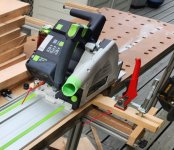 20230805_160612crop.jpg171.7 KB · Views: 621
20230805_160612crop.jpg171.7 KB · Views: 621 -
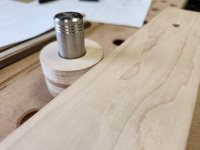 20230812_184221.jpg140.3 KB · Views: 620
20230812_184221.jpg140.3 KB · Views: 620 -
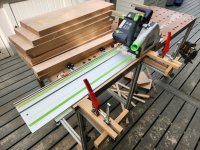 20230805_160612.jpg293.5 KB · Views: 615
20230805_160612.jpg293.5 KB · Views: 615 -
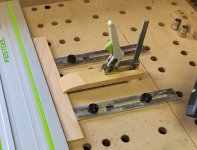 20230506_143700crop.jpg198.5 KB · Views: 611
20230506_143700crop.jpg198.5 KB · Views: 611 -
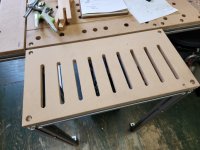 20230812_184002.jpg221.6 KB · Views: 622
20230812_184002.jpg221.6 KB · Views: 622 -
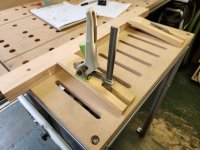 20230812_183919.jpg209.9 KB · Views: 616
20230812_183919.jpg209.9 KB · Views: 616 -
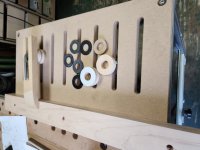 20230812_184120.jpg205.7 KB · Views: 617
20230812_184120.jpg205.7 KB · Views: 617 -
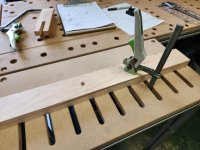 20230812_184330.jpg240.2 KB · Views: 608
20230812_184330.jpg240.2 KB · Views: 608
